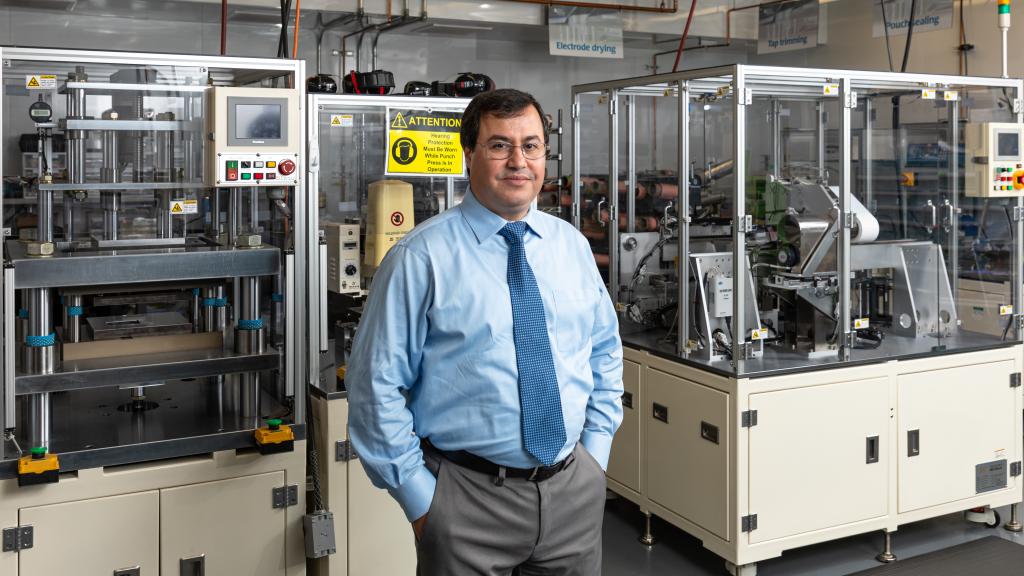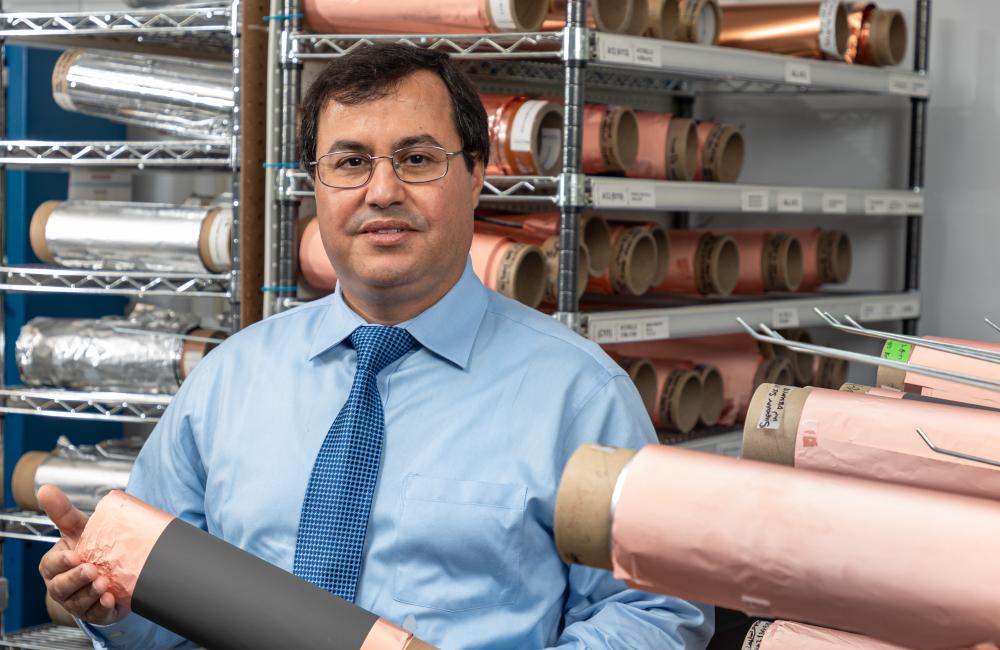Ilias Belharouak is leading ORNL’s research efforts in investigating new materials for solid-state batteries, which can double the charging capacity of lithium-ion batteries, commonly used today for electronic devices such as cell phones.
Ask Ilias Belharouak what’s on his mind at any moment, and the answer will inevitably be energy storage. The ORNL materials scientist is on a mission to discover what’s beyond lithium-ion batteries — specifically, how to use new materials to develop smaller, more powerful next-generation batteries.
Belharouak, a group leader for roll-to-roll manufacturing, has devoted the past 25 years to battery research. He’s studied with Nobel Prize-winning scientists and had the opportunity to work with one of the inventors of lithium-ion batteries.
“I’ve been mentored by some of the greatest minds in chemistry,” Belharouak said. “I listen to those who have gone before me; it’s their legacies that I’m responsible for carrying through in my research today.”
One of the most important lessons he’s learned over the years is that you can’t possibly improve a technology without first understanding that technology’s basic building block — the material.
“If we want to create a more powerful battery, it starts with having a fundamental and atomic-level understanding of the materials that batteries are typically made from, like transition metal oxides, using supercomputers and advanced characterization tools such as neutrons to explore,” he said.
Batteries made from lithium-ion are rechargeable and widely used today to power electronic devices such as cell phones. This may still seem like new technology, but Belharouak noted lithium-ion batteries have been around since 1991.
“We’ve reached the capacity of how much we can get out of lithium-ion batteries, but we still have a tremendous need for them as technology continues to evolve and grow,” he said.
Belharouak expects that solid-state batteries will take over after lithium-ion, providing the energy density to power the future. These batteries use solid-state composite cathodes and a solid electrolyte instead of liquid or polymer gel electrolytes found in lithium-ion or lithium polymer batteries.
Solid-state batteries have the potential to nearly double the 250-kilowatt hour capacity of today’s best lithium-ion batteries.
Solid-state batteries can have fast charging times and are safer because of the lower heat generation and absence of liquid electrolytes. They also have a longer life span and the potential for lower manufacturing costs.
“While solid-state batteries have the highest potential for packing energy, they’re currently too expensive to manufacture and can pose a greater risk for short-circuiting,” Belharouak said. “The key to overcoming these challenges is in the materials development.”
Belharouak expects to advance the development of solid-state batteries through studying not only materials, but also manufacturing processes. In support of his vision, the Battery Manufacturing Facility at ORNL has expanded to include a designated research space specifically for the research and development of solid-state batteries.
“Instead of buying a material from a company so that you can put into a research process at the lab, I want us to make that material so that we are in full control over it and can understand it,” he said.
Grounding guidance
Growing up in Morocco as one of seven children, Belharouak learned early on the value of achieving goals with ingenuity. His father was a teacher and shared with Belharouak the importance of education and learning how to do things yourself.
“My father had the most impact on me and taught me self-reliance,” he said. “He had a small garage he would work in, and I would go visit him there because I knew I would have alone time and his full attention. So, he would tell me when I would show up, ‘Go, build something, you have tools here, figure it out.’”
A young Belharouak took heed and realized that he enjoyed carpentry. Through trial and error, he taught himself how to make small chairs.
“After I had filled the garage with many chairs, my father said, ‘See, you did that, and look at the results!’” he remembered. “I guess that was the beginning of my journey to becoming a scientist, because I knew I loved solving problems, inventing things, and science allows me to do that.”
Mentors have guided Belharouak’s scientific path for most of his life. Because of his academic excellence, he was recommended by a professor in Morocco to continue his studies at the National Center for Scientific Research at Bordeaux University in France. He stayed on there as a postdoc, completing a materials science and solid-state chemistry degree and focusing on catalysis and optical materials.
His work at Bordeaux quickly attracted the attention of the United States, where he was tapped to lead several battery projects for Argonne National Laboratory.

“I was a visiting scientist initially at Argonne, but I knew I wasn’t going to return to France because I needed to spread my wings,” Belharouak said. “I thought I would go back to Morocco and work in a university, but I knew there was such opportunity in the U.S. that I needed to stay there, so I turned the temporary position into permanent, leading a team of researchers.”
After 12 years at Argonne, Belharouak once again had the urge to move on.
“I was at the top of my research career at Argonne, and I started thinking that it was time to pursue an academic career because I always wanted to be a professor,” he said “I knew at some point in my life I would probably end my career in academia.”
While on the verge of taking a position at Central Michigan University, Belharouak received an offer that changed the trajectory of his career.
From Qatar to ORNL
In 2013, Belharouak joined the Qatar Foundation for Education, Science and Community Development in Doha, where he served as the director for Qatar’s new energy storage research.
“I had to build the energy storage program at Qatar from the ground up,” Belharouak said. “In my first year I hired 13 people from all over the world with every single expertise in batteries, material science, solid-state, polymer science and chemistry.”
Not only did Belharouak establish the research team, but he also designed lab space and supervised the installation of equipment.
“My experience in Qatar was so rich, so engaging, so nurturing — but it was also so draining,” he said. “I built something from scratch, and today the original team of researchers has positioned Qatar on the map of energy storage.”
In 2017, he was recruited by ORNL leadership to join the laboratory to spearhead energy storage research just as he did at Qatar.
“After my first visit to ORNL, I knew that this was where I needed to be,” he said. “This is the perfect place to return to the laboratory environment.”
Since that time, he has worked to increase the number of patents, publications and proposals in his group, enhancing ORNL’s footprint in energy storage research. Belharouak himself has received more than 20 U.S. patents, including the licensing of technologies designed to eliminate cobalt metal in lithium-ion batteries and accelerate the production of electric vehicles and energy storage solutions for the power grid.
“We need significant breakthroughs in energy storage to move forward in an electrified world,” Belharouak said. “I want my team at ORNL to see themselves as contributing to the energy storage vision, knowing their scientific research and inventions can have a global impact. Energy storage impacts us all, every day. Every person here — every student, postdoc, scientist and support staff member —is an important part of finding better solutions.”
ORNL is managed by UT-Battelle for the U.S. Department of Energy's Office of Science, the single largest supporter of basic research in the physical sciences in the United States. DOE’s Office of Science is working to address some of the most pressing challenges of our time. For more information, please visit https://energy.gov/science.



